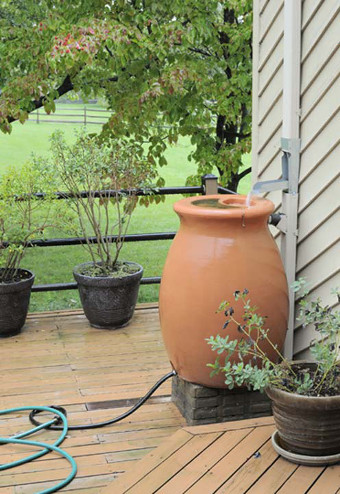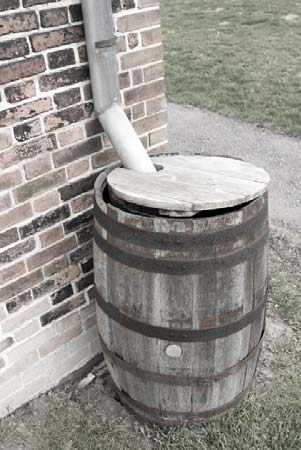
Did you know there is a way to conserve water, keep your lawn
and garden happy and pinch pennies? More and more people are
turning to rainwater harvesting as a relatively simple way to meet
all these goals.
Amid a still sluggish economy, Texans continue to look for any
means of saving money. Though high water bills typically become
an issue in the spring and summer when lawns and gardens get
thirsty, there are steps you can take now to ease the drain on your
pocketbook.
Rainwater harvesting is the capture and storage of rainwater for
later use. The simplest systems involve little more than a barrel to
hold water that drains from your roof. More elaborate systems can
include large capture areas, networks of pipes and storage tanks.
According to the Texas AgriLife Extension Service, in many
communities, 30 to 50 percent of water people use is for
landscape irrigation. Imagine the savings if instead of taking that
water from the tap, you could collect it from the source, as it falls
from the sky. Captured rainwater is ideal for landscaping and
gardening, because it is typically free of salts, disinfectant by-products, harmful minerals and other
contaminants. It needs no treatment before use.
Rainwater can also be useful in attracting and providing water for wildlife. And with proper treatment, such as
ultraviolet light or ozone, rainwater can even be made safe for people to drink.

Besides helping save you money, rainwater collection eases the strain on
municipal water supplies and groundwater. With water supplies limited and
Texas’ population expected to more than double in the next 50 years, such
alternative sources of water will prove vital to helping meet our needs.
One way to landscape homes in arid regions where water is at a premium is to
combine rainwater collection with the use of drought-hearty and native plants.
Rainwater harvesting can also help ease flooding and erosion, according to
AgriLife. It turns stormwater problems into water supply assets by slowing
runoff and allowing it to soak into the ground. This also helps reduce surface
water contamination from sediments, fertilizers, and pesticides in rainfall runoff.
Besides watering plants, people have come up with a variety of uses for this
collected water. It can be used in evaporative coolers, to flush toilets or wash
cars – even to fill chlorinated swimming pools. With in-home systems, it can extend the life of appliances by
preventing scales from forming on them.
Professionally manufactured harvesting storage containers are available on the market in a range of sizes —
from barrels that hold a few gallons to tanks that can hold thousands of gallons. But, you don’t need to spend
a lot of money to capture your own rainwater.
Harvesting systems can be as simple as a bucket placed under the downspout of your home gutters or a
children’s wading pool. Some cities even offer incentives to installing harvesting systems.
Though we always hope for plentiful rain in the Brazos basin, consider a home rain harvesting system. It will
save you a few dollars each month while conserving a vital natural resource.
For more information about rainwater collection systems, please click here. If you would like to learn more
about Xeriscaping and water conservation in general, click here.